Examine the figures A, B and C. In which one of the four options all the items A, B and C are correctly identified ?

A - Sycon, B - Euspongia, C - Spongilla
A - Euspongia, B - Spongilla, C - Sycon
A - Spongilla, B - Sycon, C - Euspongia
A - Euspongia, B - Sycon, C - Spongilla
Correct Answer :
A. A - Sycon, B - Euspongia, C - Spongilla
All the figures (A, B, and C) are the examples of porifera phylum. A, B and C are respectively Sycon, Euspongia (also called horny sponge) and Spongilla. They are primitive, sessile, aquatic, water dwelling filter feeders that pump water through their bodies to filter out particles of food matter.
Related Questions
Tracheae of cockroach and mammal are similar in having
paired nature.
non-collapsible walls.
ciliated inner lining.
origin from head.
Identify the correct characteristics of porifera.
- Commonly known as sea walnuts.
- Presence of ostia and collar cells.
- Exhibit tissue level of characteristics.
- It is the largest phylum of animal kingdom.
- The body is supported by spicules and sponging fibers.
- Contains cnidocytes which is used for defense, anchorage and capturing of prey.
(ii), (v) only
(i), (ii), (vi) only
(i), (ii), (iii), (iv) only
All of these.
Which of the following animal contains respiratory organs like, gills, book gills, book lungs or tracheal system?
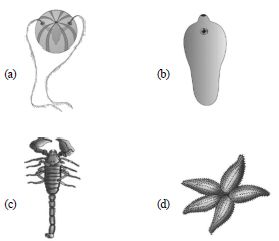
Click to check answer
Click to check answer
Click to check answer
Click to check answer
In amphibians, heart is ________ chambered.
two
three
four
none of these
Which of the following statements (i - v) are correct ?
(i) The pelvic fins of female sharks bear claspers.
(ii) In Obelia, polyps produce medusae sexually and medusae form the polyps asexually.
(iii) Flame cells in platyhelminthes help in osmoregulation and excretion.
(iv) In non-chordates, central nervous system is ventral, solid and double.
(v) Pinnae are present in mammals.
(ii), (iv) and (v)
(i), (iii) and (v)
(iii), (iv) and (v)
(i), (ii) and (iii)
Which of the following is a chordate feature and not shared by the non-chordates ?
Metamerism
Axial organization
Bilateral symmetry
Pharyngeal gill slits
Which of the following characteristics is correct for reptilia?
Body covered with dry and cornified skin, scales over the body are epidermal, they do not have external ears.
Body is covered with moist skin and is devoid of scales, the ear is represented by a tympanum, alimentary canal, urinary and reproductive tracts open into a common cloaca.
Fresh water animals with bony endoskeleton and airbladder regulate buoyancy.
Marine animals with cartilaginous endoskeleton and body is covered with placoid scales.
The given figures A, B, C and D are the examples of first true land vertebrates. They are dominant in mesozoic era and belong to phylum ‘X’. Identify ‘X’ and the animals which have four chambered heart.
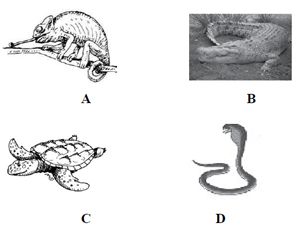
X – Reptile; B
X – Reptile; A
X – Amphibia, C
X – Pisces; D
Which of the following statement(s) is/are correct?
(i) Animals in which the cells are arranged in two embryonic layers, an external ectoderm and an internal endoderm, are called diploblastic animals.
(ii) Notochord is an ectodermally derived rod like structure formed on the ventral side during embryonic development in some animals.
(iii) In some animals, the body cavity is not lined by mesoderm, instead, the mesoderm is present as scattered pouches in between the ectoderm and endoderm and such a body cavity is called pseudocoelom.
Only (i)
Both (i) and (ii)
Both (i) and (iii)
All of these
Which of the following statement(s) is/are correct regarding class aves?
(i) The forelimbs are modified into wings and the hindlimbs generally have scales and are modified for walking, swimming or clasping the tree branches.
(ii) Heart is completely four-chambered.
(iii) They are warm- blooded (homoiothermous) animals i.e., they are able to maintain a constant body temperature.
(iv) They are oviparous and development is direct.
Both (i) and (iii)
Both (i) and (iv)
(i), (ii) and (iii)
All of these
In amphibians, respiration occurs through
gills
lungs
skin
all of these
Which of the following is not a characteristic feature of kingdom animalia ?
Storage of carbohydrates as starch.
Multicellularity.
Obtaining nutrients by ingestion.
Having eukaryotic cells without walls.
The figure given below shows the germinal layers marked as A, B, C and D. Identify the label showing undifferentiated layer and its location?
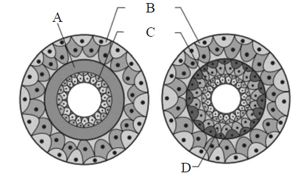
A, Between B & C
B, Between A & C
C, Between C & D
D, Between A & B
Identify the figure with its correct name and phylum.
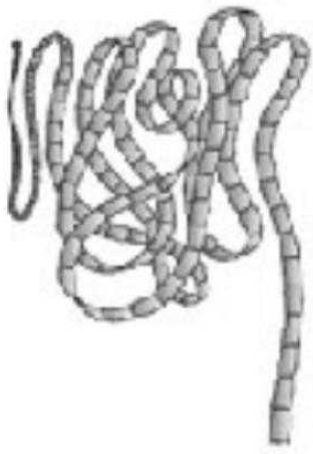
Sycon - Porifera
Aurelia - Coelenterata
Pleurobrachia - Ctenophora
Tapeworm - Platyhelminthes
Which one of the following groups of animals is correctly matched with its characteristic feature without even a single exception ?
Reptilia : possess 3 - chambered heart with one incompletely divided ventricle.
Chordata : Possess a mouth provided with an upper and lower jaw.
Chondrichthyes : Possess cartilaginous endoskeleton.
Mammalia : Give birth to young one.
Which of the following feature in birds indicates their reptilian ancestory ?
Eggs with a calcareous shell
Scales on their hind limbs
Four-chambered heart
Two special chambers-crop and gizzard in their digestive tract
Which of the following group of animals reproduces only by sexual means?
Ctenophora
Cnidaria
Porifera
Protozoa
Examine the figures A, B and C. In which one of the four options all the items A, B and C are correctly identified ?

A - Sycon, B - Euspongia, C - Spongilla
A - Euspongia, B - Spongilla, C - Sycon
A - Spongilla, B - Sycon, C - Euspongia
A - Euspongia, B - Sycon, C - Spongilla
Which of the following is not a characteristic of phylum echinodermata ?
They have a water vascular system.
They have an internal skeleton.
They are protostomes.
They have bilateral symmetry at larval stage.
Hemichordates have now been placed with the nonchordates, close to echinoderms, because true
notochord is absent.
pharyngeal gill-slits are lacking.
dorsal nerve cord is absent.
heart is lacking.
Match the phylum given in column - I with their example given in column - II and choose the correct option.
| Column -I | Column- II |
|---|---|
| (Phylum) | (Examples) |
| A. Echinodermata | I. Ascidia, Doliolum |
| B. Hemichordata | II. Asterias, Ophiura |
| C. Urochordata | III. Branchiostoma |
| D. Cephalochordata | IV. Balanoglossus, Saccoglossus |
A IV; B II; C I; D III
A II; B IV; C I; D III
A II; B IV; C III; D I
A II; B I; C IV; D III
The given figure shows some characteristic features marked as chordates. Identify the correct labelling A,B,C and D.
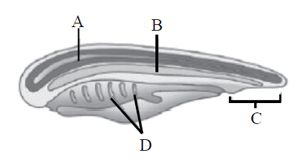
A-Notochord; B-Post-anal part; C-Gill slits; D-Nerve cord
A-Nerve cord; B-Notochord; C-Post-anal part; D-Gill slits
A-Notochord; B-Nerve cord; C-Gill slits; D-Post-anal part
A-Gill slits; B-Post-anal part; C-Nerve cord; D-Notochord
Column-I contains organisms and column-II contains their exeretory structures. Choose the correct match form the options given below.
| Column- I | Column -II |
|---|---|
| (Organism) | (Excretory structures) |
| A. Cockroach | I. Nephridia |
| B. Cat fish | II. Malpighian tubules |
| C. Earthworm | III. Kidneys |
| D. Balanoglossus | IV. Flame cells |
| E. Flatworm | V. Proboscis gland |
A I; B III; C II; D IV; E V
A III; B I; C II; D V; E IV
A II; B I; C III; D V; E IV
A II; B III; C I; D V; E IV
Which of the following belong to phylum arthropoda?
Bombyx and Apis
Laccifer and Anopheles
Locusta and Limulus
All of the above
Which of the following statements is incorrect ?
Prawn has two pairs of antennae.
Nematocysts are characteristic feature of the phylum cnidaria.
Millipedes have two pairs of appendages in each segment of the body.
Animals that belong to phylum porifera are exclusively marine.
Aquatic annelids (like Nereis) possess lateral appendages called ______________, which help in swimming.
visceral hump
parapodia
radula
spicules
Which of the following is a fresh water sponge?
Sycon
Euspongia
Spongilla
Pleurobrachia
Which of the following statements (i v) are incorrect?
(i) Parapodia are lateral appendages in arthropods used for swimming.
(ii) Radula in molluscs are structures involved in excretion.
(iii) Aschelminthes are dioecious.
(iv) Echinoderm adults show radial symmetry.
(v) Ctenophorans are diploblastic.
(i) and (ii)
(i) and (iii)
(i), (iv) and (v)
(iii) and (v)
Which of the following class is being described by the given statements (i - iv)?
(i) They are found in a variety of habitats- polar ice-caps, deserts, mountains, forests, grasslands and dark caves.
(ii) Most unique mammalian characteristic is the presence of mammary glands by which the young ones are nourished.
(iii) Heart is four-chambered.
(iv) Sexes are separate and fertilization is internal.
Reptilia
Aves
Mammalia
Amphibia
Identify the figures and select the correct option
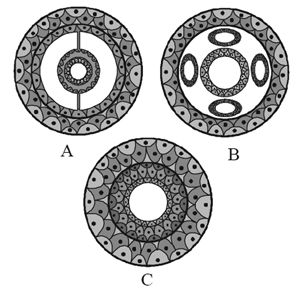
A - Pseudocoelomate; B - Coelomate, C-Acoelomate
A - Coelomate, B - Pseudocoelomate, C- Acoelomate
A - Coelomate; B- Acoelomate; C - Pseudocoelomate
A - Coelomate; B- Acoelomate; C-Eucoelomate
